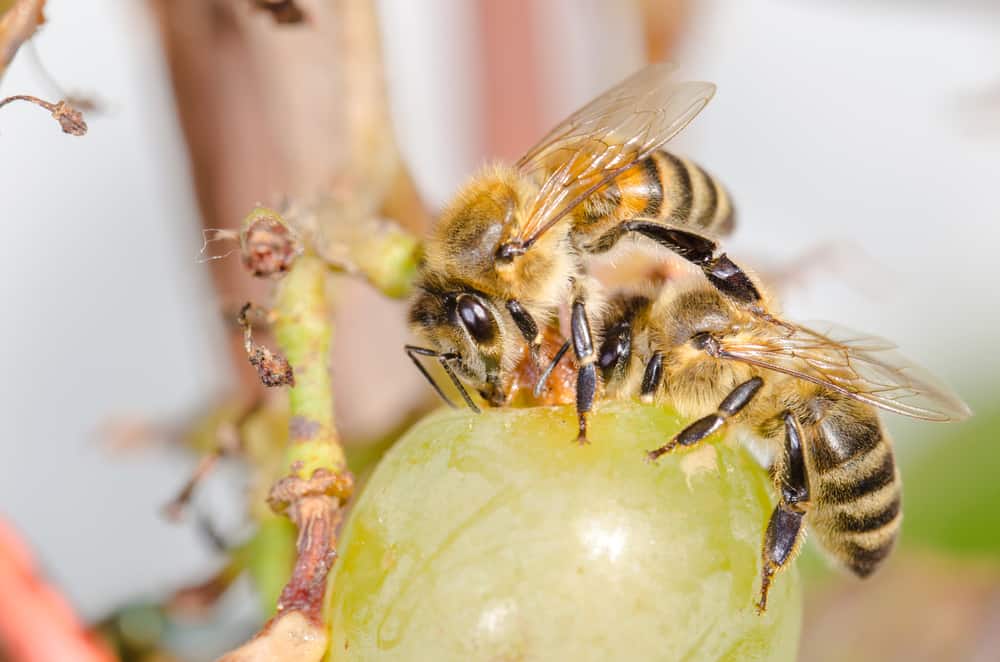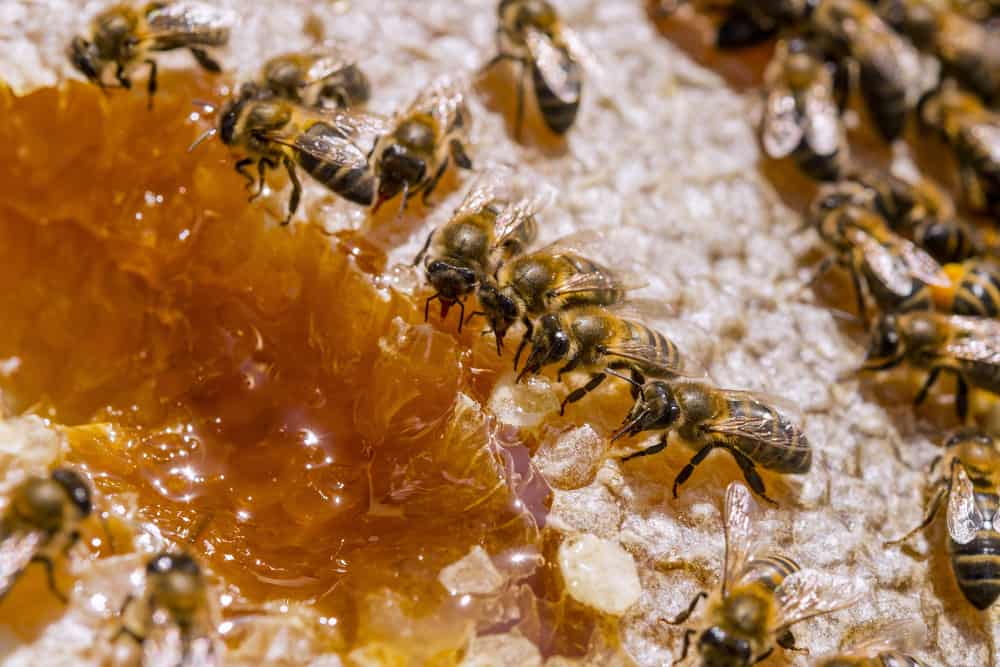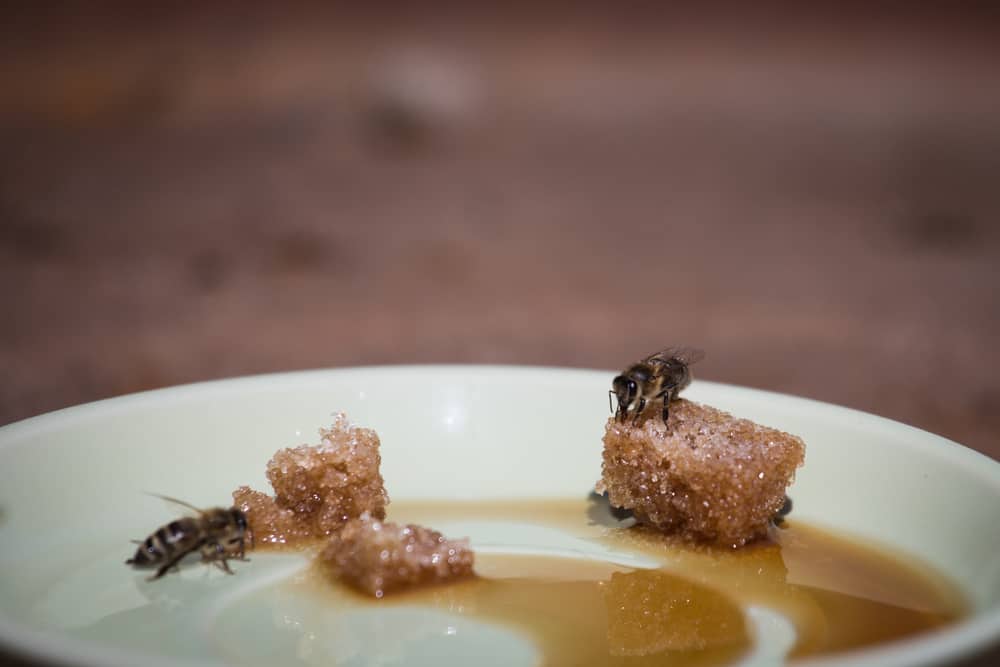Some people are terrified of bees, but most of us can appreciate their incredible value for our planet. Bees are needed for the pollination process worldwide. In addition, they make honey which is one of the world’s most luxurious and popular delights. As we think about all the wonderful things bees do for us, we might wonder what bees eat.
Bee Habits and Biology
Most people find it hard to distinguish between bumblebees and carpenter bees. Two factors can tell you whether the bee in your garden is a bumblebee or a carpenter bee: the building style of the nests and the bee’s appearance. A carpenter bee builds a simple nest with a perfectly round entrance hole. In addition, carpenter bees have smooth abdomens while bumblebees have fuzzy bellies.
There are more than 200 different species of bumblebees on our planet, and amazingly, each species has its own preferred nectar and flowers.
Bumblebees are vital insects since they pollinate flowers while looking for food. That is why gardeners are usually delighted to see bumblebees buzzing around in their gardens.
There are few predators found in nature that feed on bumblebees, with skunks being their biggest enemy. When a skunk finds a bumblebee nest, skunks will consume the adult bees and the larvae. The adult bees might sting to save themselves and their hive, but skunks ignore the pain as they love eating bees so much.
Every spring, the queen bumblebee will come out of her hibernation and search for a new place to build a nest and begin with a new colony. The queen has already been fertilized by then, and she can live through the winter while all other bees die. It is uncommon for a queen bumblebee to use the same nesting spot as before, so she constantly searches for a new place.
She will lay her eggs while gathering nectar for the grubs that will soon hatch. Once they emerge, the queen spins a silk cocoon for each of them that is meant to be protective. From this initial batch, between five and 20 daughters will begin working on the colony immediately. After that, the queen will continue to lay eggs for the rest of the summer.
Surprisingly, worker bees are the only bees that can sting. In addition, they can flap their wings up to an astonishing 230 flaps per second.
What Do Bees Like to Eat Most?
Bees are typically herbivorous since they don’t eat meat. However, there are some rare exceptions to this. For example, there is a species of bees called Vulture bees that will eat meat. These bees will consume dead insects or lizards. However, all other bee species won’t eat meat. Here are the foods that the rest of the bee species like to eat the most:
- Royal jelly – Young worker bees secrete a protein-rich substance that is called royal jelly. They secrete it from their hypopharyngeal glands, which can be found on the sides of their heads. Bee larvae are fed royal jelly as it is rich in protein and enables the larvae to grow fast to help the worker bees build the colony. Bees that are destined to become the queen bee are fed only royal jelly throughout their lives.
- Bee bread – It is a mixture of pollen and honey that will usually be given to grubs destined to be worker bees. Male bees called drones are also fed a bit of bee bread throughout their lives to keep their health and strength high.
- Honey – Honey is made and stored for consumption of the colony during cooler months since fewer flowers are accessible.
- Honeydew – This is a liquid that is very sticky and rich in sugar. Some insects and aphids secrete honeydew while they eat the sap of plants. Although it isn’t necessarily as preferred as honey, if food is scarce, bees will eat honeydew.
- Fruit – Bees have been known to eat fruit, including pears, grapes, plums, apples, and peaches.
It is apparent that bees are a great functioning species with the ability to survive over thousands of years by using what is surrounding them and feeding their colony with protein-high substances.
Food to Avoid Feeding Bees
If you are keeping bees or you just enjoy seeing them in your garden, you might be tempted to feed them from time to time. Bees are extremely beneficial insects to have in your garden, and therefore, it is not unusual for people to feed bees at all, but they need to know exactly which foods they need to avoid when it comes to feeding bees. By feeding your bees food with low nutritional value, you can risk severe health consequences in your bees. Here are foods that you should not be giving to your bees:
- You should never give your bees honey if you don’t know the source of it. This is because honey from an unknown source can expose the bees to spores carrying diseases, including American Foulbrood. Therefore, only feed honey to your bees if they made it or you know the honey’s source is trustworthy.
- Sugar that contains additives should never be fed to bees. They can’t process additives, and by exposing them to it, you can make your bees very ill.
- Brown sugar that contains molasses can be harmful to bees as they don’t have the digestive system to break it down. It is best to avoid giving it to your bees.
- You might be tempted to give your bees commercial fondant, but you should avoid doing so. Commercial fondant often contains additives, coloring, and flavoring that bees can’t consume. By giving your bees artificial flavoring, coloring, or additives, you risk the odds of your bees getting bee dysentery.
- Never give your bees products containing hydroxymethylfurfural (HMF) since it is highly toxic for bees and will kill your bees. If you are looking for high-fructose corn syrup for your bees, always check the label to ensure that it doesn’t contain HMF.
Tips on Feeding Bees
When it comes to taking care of your bees, there are ways to boost their health and things that you should avoid doing at all costs. Here are a few tips for feeding bees:
- Never feed your bees honey or fruit that has been exposed to pesticides because it can kill your bees or make them very ill.
- If you aren’t sure about the quality of the honey that you are about to give your bees, best avoid giving it to them since low-quality honey can make them sick.
- If you don’t have honey to feed your bees, you can make a straightforward sugar syrup. You can use white sugar to make it, but be sure to use clean utensils when making the sugar syrup. In fall and winter, you can feed your bees this simple sugar syrup by adding one part of water to two parts of sugar.
- If you live in an area that gets below 50°F, you should use sugar cakes or fondant that is additive-free instead of syrups. Always be sure to read the label of fondant before giving it to your bees.
- If you are feeding your bees only sugar, they are not getting micronutrients that they would have obtained from honey. Therefore, it is a good idea to add extra nourishment by boosting nutrients suitable for bees. Examples of this are Pro-Health and Honey-B-Healthy.
- If you live in a place where the temperature is hot, you can consider using liquid feed. You can make use of internal feeders, so it won’t be necessary for your bees to go out to feed. If you are worried about mold, consider investing in a mold inhibitor.
- If you live in a place that gets very cold, consider using a mountain camp rim, a candy board, or even a sugar cake-filled shallow super. This will solve the problem of your bees having to go out when it is freezing outside.
- You should be aware of the weight of your hive throughout the year, especially in the fall. If you find that your hive is very lightweight when fall approaches, you should immediately start feeding your bees sugar syrup. If it is too cold for liquid feeding, try a sugar cake or fondant.
- It is good to feed both honey and sugar during colder months since the bees might require more nutrients. Therefore, give your bees access to a sugar cake and some honey to ensure well-fed bees year-round.
- On dry and sunny days, you can check your hive more closely. Whenever possible, move your honey frame as close to your hive as you can. Even better would be to incorporate your honey into the feeding as much as possible. Unfortunately, many people think that if bees survive the colder months, they require less care over the warmer months, but this isn’t the case.
Summary
Bees produce honey and valuable propolis that has incredible health benefits for humans. In fact, our planet can’t thrive without these fantastic little creatures. Luckily, people have become more aware of the world’s dependence on bees, and you find more people taking special care of them globally. So if you are considering treating your bees to a special delight, keep in mind what bees like to eat.


